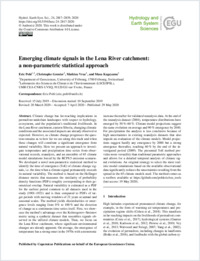Emerging climate signals in the Lena River catchment: a non-parametric statistical approach
- Pohl, Eric Department of Geosciences, University of Fribourg, 1700 Fribourg, Switzerland - Laboratoire des Sciences du Climat et de l'Environnement (LSCE/IPSL), UMR CEA-CNRS-UVSQ, 91120 Gif-sur-Yvette, France
- Grenier, Christophe Laboratoire des Sciences du Climat et de l'Environnement (LSCE/IPSL), UMR CEA-CNRS-UVSQ, 91120 Gif-sur-Yvette, France
- Vrac, Mathieu Laboratoire des Sciences du Climat et de l'Environnement (LSCE/IPSL), UMR CEA-CNRS-UVSQ, 91120 Gif-sur-Yvette, France
- Kageyama, Masa Laboratoire des Sciences du Climat et de l'Environnement (LSCE/IPSL), UMR CEA-CNRS-UVSQ, 91120 Gif-sur-Yvette, France
-
29.05.2020
Published in:
- Hydrology and Earth System Sciences. - 2020, vol. 24, no. 5, p. 2817–2839
English
Climate change has far-reaching implications in permafrost-underlain landscapes with respect to hydrology, ecosystems, and the population's traditional livelihoods. In the Lena River catchment, eastern Siberia, changing climatic conditions and the associated impacts are already observed or expected. However, as climate change progresses the question remains as to how far we are along this track and when these changes will constitute a significant emergence from natural variability. Here we present an approach to investigate temperature and precipitation time series from observational records, reanalysis, and an ensemble of 65 climate model simulations forced by the RCP8.5 emission scenario. We developed a novel non-parametric statistical method to identify the time of emergence (ToE) of climate change signals, i.e. the time when a climate signal permanently exceeds its natural variability. The method is based on the Hellinger distance metric that measures the similarity of probability density functions (PDFs) roughly corresponding to their geometrical overlap. Natural variability is estimated as a PDF for the earliest period common to all datasets used in the study (1901–1921) and is then compared to PDFs of target periods with moving windows of 21 years at annual and seasonal scales. The method yields dissimilarities or emergence levels ranging from 0 % to 100 % and the direction of change as a continuous time series itself. First, we showcase the method's advantage over the Kolmogorov–Smirnov metric using a synthetic dataset that resembles signals observed in the utilized climate models. Then, we focus on the Lena River catchment, where significant environmental changes are already apparent. On average, the emergence of temperature has a strong onset in the 1970s with a monotonic increase thereafter for validated reanalysis data. At the end of the reanalysis dataset (2004), temperature distributions have emerged by 50 %–60 %. Climate model projections suggest the same evolution on average and 90 % emergence by 2040. For precipitation the analysis is less conclusive because of high uncertainties in existing reanalysis datasets that also impede an evaluation of the climate models. Model projections suggest hardly any emergence by 2000 but a strong emergence thereafter, reaching 60 % by the end of the investigated period (2089). The presented ToE method provides more versatility than traditional parametric approaches and allows for a detailed temporal analysis of climate signal evolutions. An original strategy to select the most realistic model simulations based on the available observational data significantly reduces the uncertainties resulting from the spread in the 65 climate models used. The method comes as a toolbox available at https://github.com/pohleric/toe_tools (last access: 19 May 2020).
- Faculty
- Faculté des sciences et de médecine
- Department
- Département de Géosciences
- Language
-
- English
- Classification
- Meteorology, climatology
- Other electronic version
- License
-
License undefined
- Identifiers
-
- RERO DOC 328636
- DOI 10.5194/hess-24-2817-2020
- Persistent URL
- https://folia.unifr.ch/unifr/documents/308782
Statistics
Document views: 117
File downloads:
- pdf: 213
